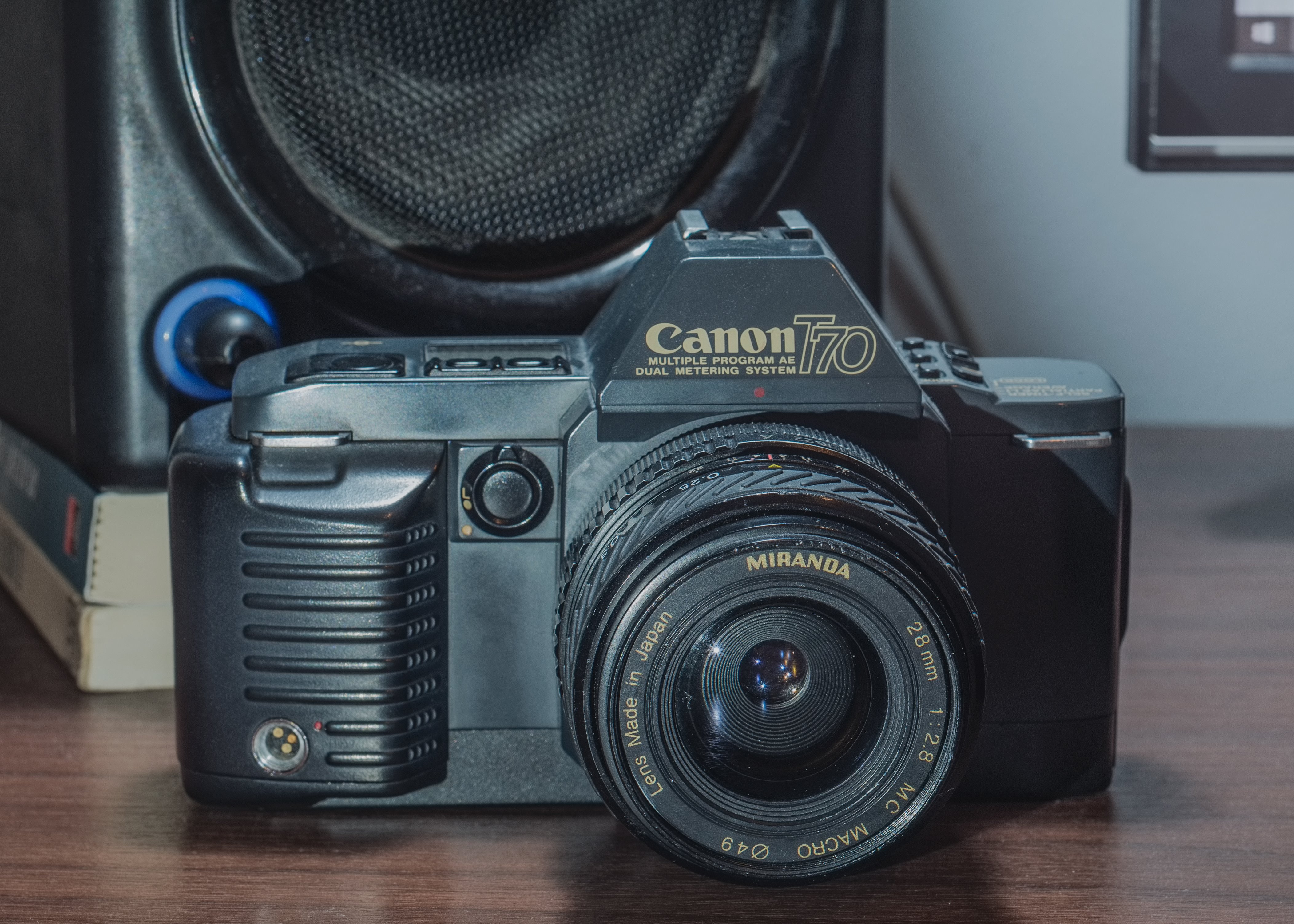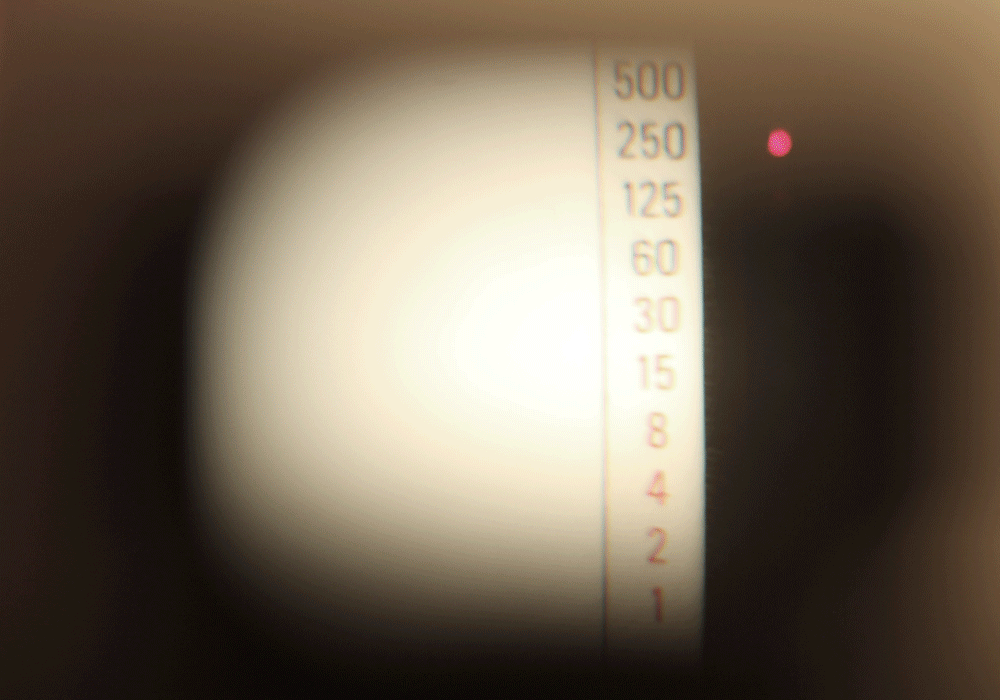|
Canon T70
The Canon T70 was a 35mm FD-mount single-lens reflex camera introduced in April 1984 as the second in Canon's T series. The T70 started with the concepts explored in 1983's T50, took them further, and applied them to a more sophisticated camera. While the Program AE-only T50 was intended as a beginner's camera, the T70 gave the photographer a lot more control over the camera's operation while keeping the T-series philosophy of simplicity in control and operation intact. Camera features Power All film transport on the T70 was powered—loading, advance and rewind. The continuous shooting rate, at 0.7 frames per second, was slower than rival motor drives, but the drive was nonetheless faster than most people could manually wind. To load the camera, the photographer simply had to pull the film leader out to an orange mark and close the back—the camera did the rest, loading the leader onto the spool, and advancing to the first frame automatically. All powered camera func ... [...More Info...] [...Related Items...] OR: [Wikipedia] [Google] [Baidu] |
Canon (company)
is a Japanese multinational corporation headquartered in Ōta, Tokyo, Japan, specializing in optical, imaging, and industrial products, such as lenses, cameras, medical equipment, scanners, printers, and semiconductor manufacturing equipment.Corporate Profile " ''Canon''. Retrieved on 13 January 2009. Canon has a primary listing on the and is a constituent of the Core30 and index. It has a secondary ... [...More Info...] [...Related Items...] OR: [Wikipedia] [Google] [Baidu] |
Canon T70 Mode Switch
Canon or Canons may refer to: Arts and entertainment * Canon (fiction), the conceptual material accepted as official in a fictional universe by its fan base * Literary canon, an accepted body of works considered as high culture ** Western canon, the body of high culture literature, music, philosophy, and works of art that is highly valued in the West * Canon of proportions, a formally codified set of criteria deemed mandatory for a particular artistic style of figurative art * Canon (music), a type of composition * Canon (hymnography), a type of hymn used in Eastern Orthodox Christianity. * ''Canon'' (album), a 2007 album by Ani DiFranco * ''Canon'' (film), a 1964 Canadian animated short * ''Canon'' (game), an online browser-based strategy war game * ''Canon'' (manga), by Nikki * Canonical plays of William Shakespeare * ''The Canon'' (Natalie Angier book), a 2007 science book by Natalie Angier * ''The Canon'' (podcast), concerning film Brands and enterprises * Cano ... [...More Info...] [...Related Items...] OR: [Wikipedia] [Google] [Baidu] |
Macro Photography
Macro photography (or photomacrography or macrography, and sometimes macrophotography) is extreme close-up photography, usually of very small subjects and living organisms like insects, in which the size of the subject in the photograph is greater than life size (though ''macrophotography'' also refers to the art of making very large photographs). By the original definition, a macro photograph is one in which the size of the subject on the negative or image sensor is life size or greater. In some senses, however, it refers to a finished photograph of a subject that is greater than life size. The ratio of the subject size on the film plane (or sensor plane) to the actual subject size is known as the reproduction ratio. Likewise, a macro lens is classically a lens capable of reproduction ratios of at least 1:1, although it often refers to any lens with a large reproduction ratio, despite rarely exceeding 1:1. Apart from technical photography and film-based processes, where the s ... [...More Info...] [...Related Items...] OR: [Wikipedia] [Google] [Baidu] |
Canon FL
Canon FL refers to a lens mount standard for 35mm single-lens reflex cameras from Canon. It was introduced in April 1964 with the Canon FX camera, replacing the previous Canon R lens mount. The FL mount was in turn replaced in 1971 by the Canon FD lens mount. FL lenses can also be used on FD-mount cameras. Many mirrorless interchangeable-lens cameras are able to use Canon FL lenses via an adapter. FL cameras * Canon FX (1964) * Canon FP (1964) * Canon Pellix (1965) * Canon FT QL (1966) * Canon Pellix QL (1966) * Canon TL (1968) FL lenses Zoom Wide-angle (under 50mm) Standard (50–60mm) Source: Canon released 3 'levels' of standard lenses (exc. macro). The f/1.8 lenses were small and lightweight, f/1.4 were mid-range, and the f/1.2 were professional level (top of their line). Telephoto (above 60mm) Notes # The FL 19mm F3.5 (not the 19mm F3.5 R) was a true wide angle (short focus) lens. Its rear projected far into the mirror box on an SLR, and becaus ... [...More Info...] [...Related Items...] OR: [Wikipedia] [Google] [Baidu] |
Self-timer
A self timer is a device on a camera that gives a delay between pressing the shutter release and the shutter's firing. It is most commonly used to let the photographer to take a photo of themselves (often with a group of other people), hence the name. The self-timer is also used to reduce camera shake when taking photographs in low light or with long (telephoto) lenses. The timer's delay gives the photographer time to steady the camera before the shutter fires, and allows vibrations from the mirror flipping up (on SLRs) to die out. It also eliminates any photographer-induced camera motion when the shutter button is pressed. Most modern cameras with a self-timer flash a light during the countdown, emit a beeping sound, or both. These warnings generally increase in speed or intensity during the last few seconds, to warn that the shutter is about to fire. The most common delay is ten seconds. Some cameras also have a two-second and five-second settings. A few cameras provide con ... [...More Info...] [...Related Items...] OR: [Wikipedia] [Google] [Baidu] |
Selective Area Metering
In photography, the metering mode refers to the way in which a camera determines exposure. Cameras generally allow the user to select between ''spot'', ''center-weighted average'', or ''multi-zone'' metering modes. The different metering modes allow the user to select the most appropriate one for use in a variety of lighting conditions. In complex light situations professional photographers tend to switch to manual mode, rather than depending on a setting determined by the camera. Examples of metering modes Spot metering With spot metering, the camera will measure only a very small area of the scene (1–5% of the viewfinder area). By default this is the centre of the scene. The user can select a different off-centre spot or recompose by moving the camera after metering. Certain models support a mode which allows averaging of multiple spot meter readings, and some support metering of highlight and shadow areas. Spot metering is not influenced by other areas in the frame. ... [...More Info...] [...Related Items...] OR: [Wikipedia] [Google] [Baidu] |
Overexposure
In photography, exposure is the amount of light per unit area (the image plane's illuminance times the exposure time) reaching a frame of photographic film or the surface of an electronic image sensor, as determined by shutter speed, lens F-number, and scene luminance. Exposure is measured in lux seconds, and can be computed from exposure value (EV) and scene luminance in a specified region. An "exposure" is a single shutter cycle. For example, a long exposure refers to a single, long shutter cycle to gather enough dim light, whereas a multiple exposure involves a series of shutter cycles, effectively layering a series of photographs in one image. The accumulated ''photometric exposure'' (''H''v) is the same so long as the total exposure time is the same. Definitions Radiant exposure Radiant exposure of a ''surface'', denoted ''H''e ("e" for "energetic", to avoid confusion with photometric quantities) and measured in , is given by :H_\mathrm = E_\mathrmt, where *''E''e is ... [...More Info...] [...Related Items...] OR: [Wikipedia] [Google] [Baidu] |
Underexposure
In photography, exposure is the amount of light per unit area (the image plane's illuminance times the exposure time) reaching a frame of photographic film or the surface of an electronic image sensor, as determined by shutter speed, lens F-number, and scene luminance. Exposure is measured in lux seconds, and can be computed from exposure value (EV) and scene luminance in a specified region. An "exposure" is a single shutter cycle. For example, a long exposure refers to a single, long shutter cycle to gather enough dim light, whereas a multiple exposure involves a series of shutter cycles, effectively layering a series of photographs in one image. The accumulated ''photometric exposure'' (''H''v) is the same so long as the total exposure time is the same. Definitions Radiant exposure Radiant exposure of a ''surface'', denoted ''H''e ("e" for "energetic", to avoid confusion with photometric quantities) and measured in , is given by :H_\mathrm = E_\mathrmt, where *''E''e is t ... [...More Info...] [...Related Items...] OR: [Wikipedia] [Google] [Baidu] |
Center-weighted Average Metering
In photography, the metering mode refers to the way in which a camera determines exposure. Cameras generally allow the user to select between ''spot'', ''center-weighted average'', or ''multi-zone'' metering modes. The different metering modes allow the user to select the most appropriate one for use in a variety of lighting conditions. In complex light situations professional photographers tend to switch to manual mode, rather than depending on a setting determined by the camera. Examples of metering modes Spot metering With spot metering, the camera will measure only a very small area of the scene (1–5% of the viewfinder area). By default this is the centre of the scene. The user can select a different off-centre spot or recompose by moving the camera after metering. Certain models support a mode which allows averaging of multiple spot meter readings, and some support metering of highlight and shadow areas. Spot metering is not influenced by other areas in the frame. ... [...More Info...] [...Related Items...] OR: [Wikipedia] [Google] [Baidu] |
Viewfinder
In photography, a viewfinder is what the photographer looks through to compose, and, in many cases, to focus the picture. Most viewfinders are separate, and suffer parallax, while the single-lens reflex camera lets the viewfinder use the main optical system. Viewfinders are used in many cameras of different types: still and movie, film, analog and digital. A zoom camera usually zooms its finder in sync with its lens, one exception being rangefinder cameras. History Before the development of microelectronics and electronic display devices, only optical viewfinders existed. Direct optical viewfinders Direct viewfinders are essentially miniature Galilean telescopes; the viewer's eye was placed at the back, and the scene viewed through the viewfinder optics. A declining minority of point and shoot cameras use them. Parallax error results from the viewfinder being offset from the lens axis, to point above and usually to one side of the lens. The error varies with distance, being ... [...More Info...] [...Related Items...] OR: [Wikipedia] [Google] [Baidu] |
Photocell
Photodetectors, also called photosensors, are sensors of light or other electromagnetic radiation. There is a wide variety of photodetectors which may be classified by mechanism of detection, such as photoelectric or photochemical effects, or by various performance metrics, such as spectral response. Semiconductor-based photodetectors typically photo detector have a p–n junction that converts light photons into current. The absorbed photons make electron–hole pairs in the depletion region. Photodiodes and photo transistors are a few examples of photo detectors. Solar cells convert some of the light energy absorbed into electrical energy. Types Photodetectors may be classified by their mechanism for detection: * Photoemission or photoelectric effect: Photons cause electrons to transition from the conduction band of a material to free electrons in a vacuum or gas. * Thermal: Photons cause electrons to transition to mid-gap states then decay back to lower bands, inducing ... [...More Info...] [...Related Items...] OR: [Wikipedia] [Google] [Baidu] |
Silicon
Silicon is a chemical element with the symbol Si and atomic number 14. It is a hard, brittle crystalline solid with a blue-grey metallic luster, and is a tetravalent metalloid and semiconductor. It is a member of group 14 in the periodic table: carbon is above it; and germanium, tin, lead, and flerovium are below it. It is relatively unreactive. Because of its high chemical affinity for oxygen, it was not until 1823 that Jöns Jakob Berzelius was first able to prepare it and characterize it in pure form. Its oxides form a family of anions known as silicates. Its melting and boiling points of 1414 °C and 3265 °C, respectively, are the second highest among all the metalloids and nonmetals, being surpassed only by boron. Silicon is the eighth most common element in the universe by mass, but very rarely occurs as the pure element in the Earth's crust. It is widely distributed in space in cosmic dusts, planetoids, and planets as various forms of silicon dioxide ( ... [...More Info...] [...Related Items...] OR: [Wikipedia] [Google] [Baidu] |









